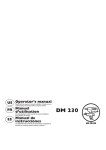Download Fisher & Paykel OB60B77CEX3
Transcript
Built-in oven User guide OB60 single, double, and compact models NZ AU GB IE SG Contents Safety and warnings Oven controls and setting manual mode Oven controls and setting the clock First use Using your oven Oven functions Baking charts Cooking with ‘auto-off’ Using the electronic timer Automatic cooking Care and cleaning Troubleshooting Warranty and service Important! SAVE THESE INSTRUCTIONS The models shown in this user guide may not be available in all markets and are subject to change at any time. For current details about model and specification availability in your country, please visit our local website listed on the back cover or contact your local Fisher & Paykel dealer. 1 2 4 5 8 9 10 12 16 18 19 20 32 33 2 Safety and warnings Your built-in oven has been carefully designed to operate safely during normal cooking procedures. Please keep the following guidelines in mind when you are using your oven: WARNING! Electrical Shock Hazard Disconnect the oven from the power supply before any cleaning or maintenance. Failure to do so may result in death or electrical shock. WARNING! Hot Surface Hazard Accessible parts may become hot when this oven is in use. To avoid burns and scalds, keep children away. Do not touch hot surfaces inside the oven. Use oven mitts or other protection when handling hot surfaces such as oven shelves or dishes. Take care when opening the oven door. Let hot air or steam escape before removing or replacing food. Failure to follow this advice could result in burns and scalds. Safety and warnings 3 Important safety instructions Isolating switch: make sure this oven is connected to a circuit which incorporates an isolating switch providing full disconnection from the power supply. Household appliances are not intended to be played with by children. Children, or persons with a disability which limits their ability to use the appliance, should have a responsible person to instruct them in its use. The instructor should be satisfied that they can use the appliance without danger to themselves or their surroundings. Safe food handling: leave food in the oven for as short a time as possible before and after cooking. This is to avoid contamination by organisms which may cause food poisoning. Take particular care during warmer weather. Do not place aluminium foil, dishes, trays, water or ice on the oven floor during cooking as this will irreversibly damage the enamel. Do not stand on the door, or place heavy objects on it. Do not use harsh abrasive cleaners or sharp metal scrapers to clean the oven door glass since they scratch the surface, which may result in shattering of the glass. Do not use a steam cleaner to clean any part of the oven. Caution. Hot air can blow from under the control panel as part of the oven’s cooling system. Do not keep flammable substances in the oven. Do not operate your appliance by means of an external timer or separate remote-control system. If the power supply cable is damaged, it must be replaced by the manufacturer, its service agent or similarly qualified person in order to avoid a hazard. Under unfavourable electrical supply conditions, the appliance may cause temporary voltage drops. 4 Oven controls and setting manual mode MODELS WITH ANALOGUE TIMER Temperature indicator light Analogue timer Temperature knob Function indicator light Function knob Fig. 1 Control panel – Models with analogue timer Important! The oven will not work until the analogue timer has been set either to manual mode or to cook with ‘auto-off’. To set manual mode Turn the analogue timer knob clockwise to the symbol. You should be able to hear a click as you turn the knob beyond the 120-minute mark. You have now set the oven to manual mode. Note: you may hear some ticking even after you have set the oven to manual mode. This is normal. To set cooking with ‘auto-off’ See section ‘Cooking with ‘auto-off’’ for instructions. Fig. 2 Setting the oven to manual mode Temperature indicator light Clock display Control buttons Temperature knob 5 Function indicator light Function knob Fig. 3 Control panel- Compact models with two cooking functions Temperature indicator light Clock display Temperature knob Function indicator light Function knob Fig. 4 Control panel- Single models with four cooking functions Buttons sets the clock, shows the time of day when oven is cooking with ‘auto-off’ set decreases time and beep volume increases time Illuminated symbols If the display shows A U T O It means that... Fig. 5 Clock display and control buttons For more information flashing The oven is ready to be set for cooking with ‘auto-off’. steadily lit The oven is set for cooking with See section ‘Cooking with auto-off’ ‘auto-off’. flashing and beeping Cooking with ‘auto-off’ has finished. To set the clock 1 2 When the power to the oven is turned on or restored after a power failure, 0.00 will flash in the display. Press . Press and until you have the correct time of day. MODELS WITH THREE-BUTTON CLOCK Oven controls and setting the clock 6 Oven controls and setting the clock Temperature indicator light MODELS WITH SIX-BUTTON CLOCK Clock display Control buttons Function indicator light Temperature knob Function knob Fig. 6 Control panel- Compact and single models with seven cooking functions 8 1 7 2 6 3 4 5 Fig. 7 Control panel- Double models with seven-function full oven and two-function compact oven 8 1 7 2 6 3 4 5 Fig. 8 Control panel- Double models with two seven-function ovens (full or compact upper oven) 1 2 3 4 Control buttons Upper oven function knob Upper oven temperature knob Lower oven function knob 5 6 7 8 Lower oven temperature knob Lower oven temperature indicator light Upper oven temperature indicator light Clock display 7 Buttons sets the timer sets the cooking time for automatic cooking sets the stop time for automatic cooking sets the clock, returns oven to manual mode, cancels automatic cooking decreases time and beep volume increases time Fig. 9 Clock display and control buttons Illuminated symbols If the display shows A U It means that... For more information flashing with 0.00 The clock needs to be set. See instructions below. steadily lit The oven is set for automatic cooking. flashing and beeping Automatic cooking has finished See section ‘Automatic cooking’ or has been set incorrectly (the stop time is before the time of day). T O steadily lit The timer is set. flashing and beeping The set time is up. See section ‘Using the electronic timer’ To set the clock 1 2 When the power to the oven is turned on or restored after a power failure, 0.00 and AUTO will flash in the display. Press . Press and until you have the correct time of day. MODELS WITH SIX-BUTTON CLOCK Oven controls and setting the clock 8 First use 1 1 2 2 3 7 8 4 9 6 5 2 3 4 5 6 7 8 9 Control panel Knobs Side rack Grill tray Oven door and handle Step-down oven shelf Flat oven shelf Side catalytic panel Rubber seal Not illustrated: Sliding shelf supports Fat filter Grill rack Baking tray Fig. 10 Oven parts (ovens vary – drawing for purposes of illustration only) Important! 1 2 3 4 5 6 Some models only have some of the features and accessories listed above. For information on accessories, contact Customer Care. Before using your new oven for cooking or baking, please: Read this user guide, taking special note of the ‘Safety and warnings’ section. Remove all accessories and packaging. Make sure you peel any protetctive film off the surfaces. Discard the film immediately, keeping it out of reach of children. If your model has side catalytic panels and sliding shelf supports, check that these are fitted. If they aren’t, see ‘Care and cleaning’ for instructions. Depending on your model, set manual mode (models with analogue timer) or set the clock (models with electronic clock). The oven will not work until this has been done. For models with analogue timer, see ‘Oven controls and setting manual mode’ for instructions. For models with electronic clock, see ‘Oven controls and setting the clock’ for instructions. Slide in the shelf/shelves and grill tray as shown in ‘Using your oven’. Condition the oven. Heat it on maximum temperature for the times below: 60 minutes using Bake 30 minutes using Fan Forced 15 minutes using Grill Note: some of these functions may not be available in some models. There will be a distintcive smell during the conditioning. This is normal, but make sure your kitchen is well ventilated. 7 Once cooled, wipe out the oven with a damp cloth and mild detergent, and dry thoroughly. Using your oven Shelf positions 6 5 4 3 9 Guard rail Stop notch Shelf positions Stop notch (NZ AU SG models only) 4 3 2 1 2 1 Fig. 11 Positioning the shelves and grill tray – full and compact ovens 1 Slide in the shelves you will need, making sure that: they are between the two wires of a shelf position or on the sliding shelf supports the stop notches point down the guard rail is at the back. Note: the grill tray should be positioned between the two wires of a shelf position or on the sliding shelf supports, and orientated as shown. 2 Select a function. The oven light(s) will come on. In single and compact models, the function indicator light will also come on. 3 Set the temperature. The temperature indicator light will come on. It will go out when the oven has reached the set temperature. Fig. 12 Turning the function knob (functions and knobs may vary) During cooking The temperature indicator light may come on and go out again as the oven maintains the temperature. A cooling fan may automatically come on at different times and blow out warm air below the control panel. It may continue to run even after the oven has been turned off. This is normal. Fig. 13 Turning the temperature knob (knobs may vary) Set the temperature back to off (0) before changing functions. When you have finished cooking Turn both the function and temperature knobs to the off (0) position. 10 Oven functions Depending on your model, your may only have some of these functions. OVEN LAMP Only the oven light comes on. It remains on in all the cooking functions. BAKE This is the traditional method of baking. It is best to bake on only one shelf at a time in this function. Ideal for large cakes and dishes that bake for several hours. GRILL Use with the oven door closed and the temperature set no higher than 225°C. For best results, use the topmost shelf position when you want quick browning (eg toast). DEFROST Only the oven fan comes on. Use with the temperature set to off (0). The fan circulates air around the oven, speeding up the defrosting process by approximately 30%. Note: this function is not for cooking food. FAN FORCED Great for multi-shelf cooking. The consistent temperature ensures baking is well risen. Cookies are crisp on the outside and chewy in the middle, meat and poultry are deliciously browned and sizzling while remaining juicy and tender. FAN GRILL Use with the oven door closed and the temperature set no higher than 220°C. Ideal for roasting tender cuts of meat and poultry. Use the lower shelf positions for larger items eg a whole chicken. OR WARM Use this function to keep cooked food hot and to warm plates and serving dishes. To reheat food from cold, set the temperature to 150°C and reduce it to 70-100°C only when the food is piping hot. Note: this function is not for cooking food and the temperature cannot be set higher than 150°C. FAN BAKE Ideal for dishes like lasagne that need to brown on top and also single trays of small cakes or biscuits that bake in less than an hour. Oven functions 11 Important! Safe food handling: leave food in the oven for as short a time as possible before and after cooking or defrosting. This is to avoid contamination by organisms which may cause food poisoning. Take particular care during warmer weather. Notes on baking: Preheat the oven before baking. Do not place anything, including water, ice or aluminium foil on the oven floor. Remove the fat filter before baking (some models only). Using the fat filter (some models only) Fan Bake, Fan Grill or Use the fat filter only when roasting meat and poultry on Fan Forced. It helps to keep your oven clean and reduces splatter and smoking. Clean the fat filter after every use. See ‘Care and cleaning’. Remove the fat filter before baking: gripping the top flap, slide up to unhook it from the rear panel. To replace the fat filter: align with the circle in the rear panel, then slide down to hook into place. Important! If the fat filter is not cleaned after every use, the grease build-up will block and shorten the life of the fan element. Fig. 14 Removing and replacing the fat filter 12 Baking charts Please note: The settings in the following charts are guidelines only. Follow the instructions in your recipe or on packaging and be prepared to adjust the oven settings and baking times to achieve the best possible results for you. Shelf positions are counted from the oven floor up (1 is the lowest, 4 or 6 the highest). Arrange oven shelves before you turn the oven on, then preheat the oven to the required temperature (until the temperature indicator light goes out). Full ovens are ideal for multi-shelf baking or larger items. Compact ovens are the ideal and most energy-efficient choice for baking small or flat items (eg cookies, pizza) on a single shelf; however, they have not been designed for multi-shelf baking. Settings in bold indicate the recommended oven function. Baking chart - full ovens The shelf positions recommended below use the flat oven shelf (not the step-down shelf ) used either with or without sliding shelf supports. Note: the step-down shelf and sliding shelf supports are not supplied with all models. BAKE Food Small cakes Scones Sponge Light fruit cake Rich fruit cake single shelf Shelf position Temperature (OC) Time (mins) 2 180-190 13-17 multi shelf single shelf not recommended 2 multi shelf 210-230 8-12 not recommended two small (20 cm), staggered on shelf 2 170-190 25-35 one large (26 cm) 2 175 30-40 2 155-165 80-100 exact baking time 2 will depend on size 130-150 3-6 hours Apple pie 1 185 35-45 Custard tart 1 220, then 180* 10, then 20-30* * This is a two-stage baking process: adjust the temperature after the first stage. continued... Baking charts Baking chart - full ovens FAN BAKE Food Small cakes Scones Sponge single shelf Shelf position Temperature (OC) Time (mins) 2 150-170 13-17 2 200-220 multi shelf single shelf not recommended multi shelf 8-12 not recommended two small (20 cm), staggered on shelf 2 160-175 20-30 one large (26 cm) 2 150 30-40 2 150-160 80-100 Light fruit cake Rich fruit cake not recommended Apple pie 1 Custard tart 160 35-45 not recommended FAN FORCED Food Small cakes Scones Sponge Light fruit cake Rich fruit cake Apple pie Custard tart Shelf position Temperature (OC) Time (mins) single shelf 2 150-170 13-17 multi shelf 1 and 5** 150-170 15-20 single shelf 2 210-230 8-12 multi shelf 1 and 5** 210-230 10-14 two small (20 cm), staggered on shelf 2 170-190 25-35 one large (26 cm) 2 175 30-40 2 155-165 80-100 exact baking time 2 will depend on size 130-150 3-6 hours 185 35-45 1 not recommended ** Use the flat shelf in position 1 and the step-down shelf in position 5. 13 14 Baking charts Baking chart - compact ovens The shelf positions recommended below use the step-down shelf without sliding shelf supports. BAKE Food Shelf position Temperature (OC) Time (mins) Small cakes 2 180-190 13-17 Scones Sponge Light fruit cake Rich fruit cake 2 210-230 8-12 two small (20 cm), staggered on shelf 2 170-190 25-35 one large (26 cm) 2 175 30-40 2 155-165 80-100 exact baking time 2 will depend on size 130-150 3-6 hours Apple pie 1 185 35-45 Custard tart 1 220, then 180* 10, then 20-30* * This is a two-stage baking process: adjust the temperature after the first stage. continued... Baking charts Baking chart - compact ovens FAN BAKE Food Shelf position Temperature (OC) Time (mins) Small cakes 2 150-170 13-17 Scones Sponge 3 200-220 8-12 two small (20 cm), staggered on shelf 2 160-175 20-30 one large (26 cm) 2 150 30-40 2 150-160 80-100 Light fruit cake Rich fruit cake not recommended Apple pie 1 Custard tart 160 35-45 not recommended FAN FORCED Food Shelf position Temperature (OC) Time (mins) Small cakes 2 150-170 13-17 Scones 2 210-230 8-12 two small (20 cm), staggered on shelf 2 170-190 25-35 one large (26 cm) 2 175 30-40 2 150-160 80-100 exact baking time 2 will depend on size 130-150 3-6 hours 185 35-45 Sponge Light fruit cake Rich fruit cake Apple pie Custard tart 1 not recommended 15 MODELS WITH ANALOGUE TIMER 16 Cooking with ‘auto-off ’ Use the analogue timer to automatically turn the oven off when the set cooking time has elapsed. To set the oven for cooking with ‘auto-off’ 1 2 Select the function and set the temperature. Turn the analogue timer knob to the length of time you want the oven to cook (up to 120 minutes). Fig. 15 Setting the timer to turn the oven off automatically Fig. 16 Changing from manual mode to cooking with ‘auto-off’ Important! If the oven is in manual mode and you want to set it to a length of time, make sure you start turning the timer knob anti-clockwise. Forcing the knob from the symbol clockwise to O (off) could damage it. When ‘auto-off’ is set The analogue timer will immediately start counting down: you will see the knob slowly rotating anti-clockwise towards the 0 (off ) position. To cancel the ‘auto-off’ setting, set the oven to manual mode by turning the analogue timer clockwise to the symbol. When the cooking time is over The oven will automatically turn off. Notes: The oven will NOT beep or ring when the set cooking time has elapsed. The oven may turn off before the marker on the timer knob lines up with the 0 (off ) position. This is normal. 17 Use ‘auto-off’ to automatically turn the oven off when the set cooking time has elapsed. To set the oven for cooking with ‘auto-off’ 1 2 Set the oven: Check the clock shows the correct time (eg 12:07). Select the function and set the temperature. The oven will turn on. Fig. 17 Three-button clock display and control buttons Set the cooking time: Decide how long the food will take to cook, allowing time for preheating if necessary (eg 40 minutes). Press . While AUTO is flashing, use and to set the cooking time (eg 40 minutes). Notes on setting the cooking time If the cooking time is 99 minutes or less: you can set it in 10-second steps the remaining time will count down in seconds (min.sec). If the cooking time is 100 minutes (ie 1 hour 40 minutes) or more: you can set it in 1-minute steps the remaining time will start counting down in minutes (h.min). When ‘auto-off’ is set The time will start counting down and the clock display will show the remaining time with AUTO steadily lit. To see the current time of day, press . To cancel the ‘auto-off’ setting, press and together. The current time of day will appear in the display. Turn the function and temperature knobs to O (off ). When the cooking time is over The oven will automatically turn off (eg at 12:47). AUTO will start flashing, the current time of day will appear in the display and the timer will beep: 1 2 Press any button to stop the beeping and return the oven to manual mode. Turn the function and temperature knobs to O (off ). MODELS WITH THREE-BUTTON CLOCK Cooking with ‘auto-off ’ MODELS WITH SIX-BUTTON CLOCK 18 Using the electronic timer You can use the timer at any time, even when the oven is not in use. Important! The timer does NOT turn the oven off. To set the timer 1 2 Press . 0.00 will show and the symbol will start flashing. Press and to set the time you want (up to 23 hours and 59 minutes, in 1-minute steps). After a few seconds, the clock will show the time of day with the symbol steadily lit. The timer is now counting down. Fig. 18 Six-button clock display and control buttons To check the remaining time Press . To cancel the timer 1 2 Press . Press until the time is reset to 0.00 After a few seconds, the clock will show the time of day. When the set time is up The timer will beep and the symbol will flash. Press to stop the beeping and turn the timer off. After a few seconds, the clock will show the time of day. To adjust the beep volume Press to hear the next volume level. The last one selected will be stored. 19 Important! In double models with compact upper ovens, only the lower (main) oven can be set for automatic cooking. In double models with two full ovens, only the upper oven can be set for automatic cooking. To set the oven for automatic cooking 1 Fig. 19 Six-button clock display Set the oven: and control buttons Check the clock shows the correct time (eg 12:07). Select the function and set the temperature. The oven will turn on. 2 Set the cooking time: Decide how long the food will take to cook, allowing time for preheating if necessary (eg 40 minutes). Press . Use and to set the cooking time. AUTO will show in the display. 3 Set the stop time: Decide when you want your food to be ready by (eg 13:30). Press . Use and to set the stop time. You can turn the oven on manually and set it to turn off automatically by setting the stop time (step 3 above). When automatic cooking is set If there is time before cooking starts, the oven will turn off and the current time of day and AUTO will show in the clock display, indicating that the oven is set for automatic cooking. Note: the cooling fan may stay on. The oven will automatically turn on at the required time (eg 12:50) and turn off at the set stop time (eg 13:30). To see the remaining cooking time, press . To see the set stop time, press . To cancel automatic cooking, press and turn the function and temperature knobs to 0 (off ). When the stop time is reached The oven will turn off, the timer will beep and AUTO will flash. 1 2 Press to stop the beeping and return the oven to manual mode. Turn the function and temperature knobs to O (off ). MODELS WITH SIX-BUTTON CLOCK Automatic cooking 20 Care and cleaning Important! Always disconnect the oven from the power supply before any cleaning or maintenance. Electronic clock models: When you turn the power back on after cleaning, you will have to set the clock. Do not use abrasive cleaners, cloths or pads to clean any part of your oven. Some nylon scourers may also scratch. Check the label. See the following pages for instructions on removing and refitting different parts of the oven for cleaning. Before cleaning, make sure the oven is a safe temperature to touch. Do not use a steam cleaner. What? How? General advice Stainless steel surfaces Wipe out the oven after every use. Wipe up spills as soon as the oven is a safe temperature to touch. 1 2 3 Wipe the soiling off with a cloth using a mild household detergent or stainless steel cleaner. Wipe the surface dry. Use a suitable stainless steel polish. Glass surfaces Wipe with a damp cloth or use a glass cleaner. Oven cavity (enamel) 1 2 3 4 Side racks, oven shelves, trays Remove everything from the oven: all shelves and trays, the side racks, the catalytic panels and fat filter if supplied. Remove the oven door (see instructions on following pages). Wipe the inside of the oven using a household detergents or an ammonia-based cleaner. Wipe clean with a damp cloth and allow to dry completely. Clean these using a solution of detergent and hot water. They are also dishwasher safe. If badly soiled, soak in a solution of hot water and biological clothes washing powder to make cleaning easier. Important! Avoid leaving alkaline or acidic substances (such as lemon juice, vinegar or salty spills) on the oven surfaces. Do not use cleaning products with a chlorine or acidic base. Immediately wipe off any caustic cleaners if they are spilled onto the oven door handle or the knobs. Do not use harsh abrasive cleaners or sharp metal scrapers since they scratch the surface and may result in the glass shattering. To make cleaning the oven ceiling easier, the grill element in some full ovens can be lowered. See Fig. 21. If using ‘off the shelf’ oven cleaners, always follow the manufacturer’s instructions. Care and cleaning What? How? If you roast or grill a lot of meat and hardly ever bake, heating an empty oven for 60-90 mins at 250oC on Bake from time to time will help the panels to break down any greasy soiling. To remove large food particles: gently wash the panels in warm soapy water. Rinse in clean water and allow to dry naturally. If the panels become oversaturated, they will appear shiny and their ability to ‘selfclean’ will be reduced. In this event, they can be reversed. Side catalytic panels (not supplied with all models) Sliding shelf supports (not supplied with all models) Wipe with a damp cloth and mild detergent. Do not wipe off or wash away the white lubricating grease (visible when the slides are extended). 21 Important! These panels are normally ‘selfcleaning’ because their special enamel breaks down greasy splatters when the oven is used for ‘non-greasy’ baking, especially at high temperatures. Never use scourers, brushes, abrasives or cleaners with acid or alkali content on the catalytic panels. Do not wash these in the dishwasher, immerse in soapy water, or use oven cleaner on them as doing so will remove the white lubricating grease and prevent the slides from running smoothly. If lightly soiled: wash in dishwasher (normal cycle). If heavily soiled: Place under water in a pan. Add two tablespoons of clothes washing powder. Bring to the boil. Leave to soak for 30 minutes. Rinse in clean water and dry. Clean after every use. If the filter is not cleaned, the grease build-up will block and shorten the life of the fan element. Rubber seal framing the oven cavity Wipe very gently with a damp cloth and mild detergent. Take care not to unhook and displace the rubber seal while cleaning it. Take care not to spray any oven cleaner or other caustic cleaner on the rubber seal, as doing so may damage the rubber. Knobs 1 Fat filter (not supplied with all models) 1 2 3 4 5 2 Wipe with a damp cloth and Do not use stainless steel or oven mild detergent. cleaner on the knobs, as doing so may Dry thoroughly with a soft cloth. damage their coating. 22 Care and cleaning Removing and refitting the side racks and catalytic panels Important! Only some full ovens have catalytic panels and a lamp in the left oven wall. Fixing screw Fixing screw hole Fig.20a Side rack and catalytic panel in full oven cavity 1 2 3 Fig.20b Side rack in compact oven cavity To remove a side rack and catalytic panel For easier access to the fixing screws, we recommend removing the oven door first. See ‘Removing and refitting the oven door.’ Using a small coin or a flat-head screwdriver, loosen and remove the front and back fixing screws, as shown. Remove the side rack. Once you have removed a side rack, the catalytic panel behind it (if fitted) will also be released. Important! In some full ovens, the back of the oven is also a catalytic panel, but this is not reversible and should not be removed. 1 2 3 4 5 6 To refit a side rack and catalytic panel If the oven has catalytic panels, align a panel with the fixing screw holes and hold it in place, making sure that: the arrow on the panel is pointing up if one panel has a hole, it will be on the left oven wall (to fit around the lamp) Loosely screw in the the back fixing screw. Position the side rack. In full ovens, make sure it is the right way up, as shown. Loosely screw in the front fixing screw. Check that both fixing screws are straight, then tighten them. If you removed the door, refit it. Care and cleaning 23 Drop-down grill element (some full ovens only) To lower the grill element: use a flat-head screwdriver or a small coin to loosen the element fixing screw. When you have finished cleaning the oven ceiling, raise the grill element and screw the element fixing screw back onto the stud. Make sure that the fixing screw is tightened and the element is held securely in place. The grill element itself is self-cleaning. Fixing screw Stud Fig. 21 Lowering the grill element 24 Care and cleaning Removing and refitting the sliding shelf supports (some models only) Important! Remove the side racks first to make removing the sliding shelf supports easier. In full ovens, the sliding supports can only be used on shelf positions 1,2 and 3. In compact ovens, the sliding shelf supports can only be used on shelf position 2. When refitting the sliding shelf supports, make sure that you fit: the side racks first the slides to the top wire of a shelf position (1,2 or 3 in full ovens; 2 in compact ovens) both sides of each pair of slides both slides on the same level. 1 2 1 Fig.22a Removing the sliding shelf supports Fig.22b Refitting the sliding shelf supports Care and cleaning Removing and refitting the glass panes of the oven door Important! Oven doors vary. Some have three glass panes, others only two. The outer pane is not removable. Take care, the glass panes are heavy. Place the removed glass panes on a safe, soft surface. To remove the glass panes 1 Open the door fully. 2 Open the levers. 3 Close door until the levers hook to the door. 4 Remove seal (some doors only). Lever Seal Hook into 25 26 Care and cleaning ....then depending on your model... MODELS WITH INNER PANE ONLY 5 Slide out the inner pane. MODELS WITH INNER AND MIDDLE PANES 5 Slide out the inner pane. 6 Slide the middle pane up slightly to unhook it from the bottom clamps. 7 Lift out the bottom edge and remove. 1 2 Care and cleaning 27 To refit the glass panes MODELS WITH INNER PANE ONLY MODELS WITH INNER AND MIDDLE PANES 1 Make sure the open levers firmly hook to the door. 1 Make sure the open levers firmly hook to the door. 2 Check the rubber pads are in place. 2 Check the rubber pads are in place. Rubber pads 3 Rubber pads Check the pane is the right way around . You should be able to read any wording that may be on the pane. 3 1 Check the pane is the right way around . You should be able to read any wording that may be on the pane. 1 cont.... 28 Care and cleaning MODELS WITH INNER PANE ONLY 4 Insert the pane into the slide guides and slide it to the bottom retainers. MODELS WITH INNER AND MIDDLE PANES 4 Insert the pane into top clamps then lower and slide into bottom clamps. Slide guides 3 F Bottom retainers 1 2 1 5 Replace the seal (some doors only). 5 Check the rubber pads are in place. Seal Rubber pads 6 6 Check the pane is the right way around . You should be able to read any wording that may be on the pane. Open the door fully and close the levers. Lever 1 cont.... Care and cleaning MODELS WITH INNER PANE ONLY 29 MODELS WITH INNER AND MIDDLE PANES 7 Insert the pane into the slide guides and slide it to the bottom retainers. Slide guides F Bottom retainers 8 Replace the seal (some doors only). Seal 9 Open the door fully and close the levers. Lever Care and cleaning 30 Removing and refitting the oven door Important! Take care, the oven door is heavy! To remove the door 1 Open the door fully. 2 Open the levers. 4 Close the door until the levers hook to it. 5 Disengage the hinges and remove the door. Lever Hook into 3 C Hold the door. To refit the door Repeat these steps in reverse order. Care and cleaning 31 Replacing the oven light bulb(s) Note: oven bulb replacement is not covered by your warranty. 1 2 Let the oven cavity and the grill element cool down. Important! Disconnect the oven from the power supply before continuing. LEFT LAMP (some models only) 3a Remove the left side rack (and catalytic panel if supplied). See ‘Removing and refitting the side racks and catalytic panels’. 4a Press down on the lamp cover and rotate to remove. Important! Never use screwdrivers or other utensils to remove the lamp cover, as doing so could damage the surrounding enamel. Only use your hands. 5a Unscrew and replace the bulb with a new one suitable for high temperatures (300oC) with the following specifications: 220-240V, E14 and same wattage as the bulb being replaced (check wattage stamped on the bulb). 6a Refit the lamp cover, operating in reverse order. Make sure that it clicks into place. Important! The notch in the inner edge of the cover must be on the side closer to the back of the oven. 7a Refit the left side rack (and the left catalytic panel if supplied). 8a Turn the power to the oven back on. Set the clock. TOP RIGHT LAMP 3b Twist the lamp cover off. 4b Unscrew and replace the bulb with a new one suitable for high temperatures (300oC) with the following specifications: 220-240V, E14 and same wattage as the bulb being replaced (check wattage stamped on the bulb). 5b Twist the lamp cover back on. 6b Turn the power to the oven back on. If your model has an electronic clock, set the clock. 1 2 Notch LEFT LAMP (some models only) Fig.23 Removing the oven lamps 32 Troubleshooting If you cant’ find an answer to your problem in the chart below, or if the problem cannot be fixed, you will need technical help. Contact your Authorised Service Centre or Customer Care. Problem The oven is not heating and the oven light is off. Possible cause No power supply to the oven. Models with analogue timer: the oven has not been set to manual mode. Models with electronic clock: the clock has not been set. Models with six-button electronic clock: the oven is set for automatic cooking. Electronic clock The power to the oven has models: 0.00 is been turned on or restored flashing in the clock after a power failure. display and the oven will not work. The oven light does The light bulb has blown. not come on, but the oven is heating. Food has high moisture Condensation: droplets of water in content or local climate or around oven (e.g. (temperature, humidity) is contributing to on control panel, condensation. oven door, rubber seal framing the cavity, surrounding cabinetry). Fan noise and A cooling fan in the oven ventilation air are runs to keep the oven coming from the door and control panel oven both during cool at all times. It may and after use. continue to run after the oven has been turned off. Uneven baking Oven not properly results. preheated. Incorrect function, bakeware, cooking time, or shelf position. What to do Check that the oven is connected to the power supply and the power is turned on. If it is and the oven still doesn’t work, there may be a power failure in your home or area. Set the oven to manual mode by turning the analogue timer knob clockwise to the symbol. Set the clock. See ‘Oven controls and setting the clock’ for instructions. See section ‘Automatic cooking’ for information. Set the clock. See ‘Oven controls and setting the clock’ for instructions. Replace the bulb. See instructions in ‘Care and cleaning’. Some condensation is normal. You can wipe the droplets off with a soft cloth. This is normal and requires no action. Put the food in the oven only when the temperature indicator light has gone out. See ‘Baking charts’ for recommendations. Warranty and service 33 Before you call for service or assistance ... Check the things you can do yourself. Refer to the installation instructions and your user guide and check that: 1 2 your product is correctly installed. you are familiar with its normal operation. If after checking these points you still need assistance or parts, please refer to the Service & Warranty document for warranty details and your nearest Authorised Service Centre, or contact us through our local website listed on the back cover. This oven has been designed and constructed in accordance with the following codes and specifications: In New Zealand and Australia: AS/NZS 60335-1 General Requirements for Domestic electrical appliances AS/NZS 60335-2-6 Particular Requirements for Domestic electrical cooking appliances AS/NZS 1044 Electromagnetic Compatibility Requirements. In Europe: Safety requirements of EEC Directive “Low voltage” 2006/95: - EN 60335-1 General Requirements for Domestic electrical appliances - EN 60335-2-6 Particular Requirements for Domestic electrical cooking appliances Safety requirements of EEC Directive “EMC” 2004/108: - EN 55014-1, EN 55014-2, EN 61000-3-2, EN 61000-3-3 Electromagnetic Compatibility Requirements Requirements of EEC Directive 93/68. European directive 2002/96/EC on Waste Electrical and Electronic Equipment (WEEE) (for European Union countries only) GB This appliance is marked according to the European directive 2002/96/EC on Waste Electrical and Electronic Equipment (WEEE). By ensuring this product is disposed of correctly, you will help prevent potential negative consequences for the environment and human health, which could otherwise be caused by inappropriate waste handling of this product. The symbol on the product, or on the documents accompanying the product, indicates that this appliance may not be treated as household waste. Instead it shall be handed over to the applicable collection point for the recycling of electrical and electronic equipment. Disposal must be carried out in accordance with local environmental regulations for waste disposal. For more detailed information about treatment, recovery and recycling of this product, please contact your local city office, your household waste disposal service or the shop where you purchased the product. www.fisherpaykel.co.nz www.fisherpaykel.com.au www.fisherpaykel.co.uk www.fisherpaykel.ie www.fisherpaykel.com.sg Copyright © Fisher & Paykel 2010. All rights reserved. The product specifications in this booklet apply to the specific products and models described at the date of issue. Under our policy of continuous product improvement, these specifications may change at any time. You should therefore check with your Dealer to ensure this booklet correctly describes the product currently available. NZ AU GB IE SG F&P PN - 590076 A F&P ITALY PN - 1103547-ß1 04.2010














































